Accounting and Governance Report: Analysis of Galore Ltd's Financials
VerifiedAdded on 2022/10/06
|6
|1140
|55
Report
AI Summary
This report delves into the accounting and governance practices of Galore Ltd., focusing on the views of the Managing Director, Sharon Shady. The first part of the report examines the factors involved in estimating the yearly allowance for doubtful debts and its impact on Galore Ltd.'s financial statements, including the impact on the income statement and balance sheet. The second part evaluates Sharon's decision to set a 5% growth rate instead of 10%, reviewing the organization's accounting policies and standards. The report also assesses how this decision influences stakeholders. The analysis covers topics such as bad debt expenses, allowance for doubtful accounts, and the sustainability of growth rates, concluding that Sharon's decisions are beneficial for the organization and its stakeholders.
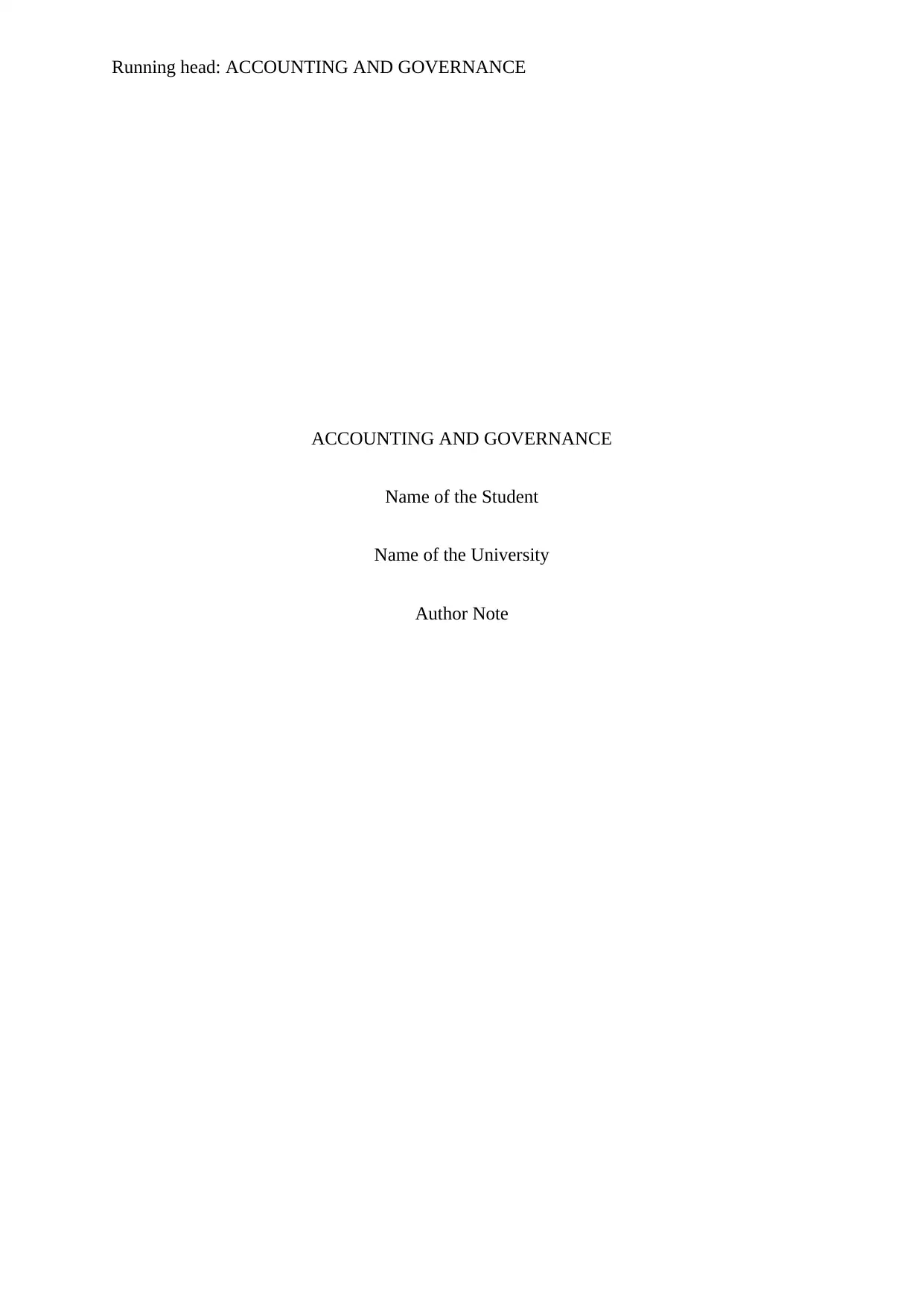
Running head: ACCOUNTING AND GOVERNANCE
ACCOUNTING AND GOVERNANCE
Name of the Student
Name of the University
Author Note
ACCOUNTING AND GOVERNANCE
Name of the Student
Name of the University
Author Note
Paraphrase This Document
Need a fresh take? Get an instant paraphrase of this document with our AI Paraphraser
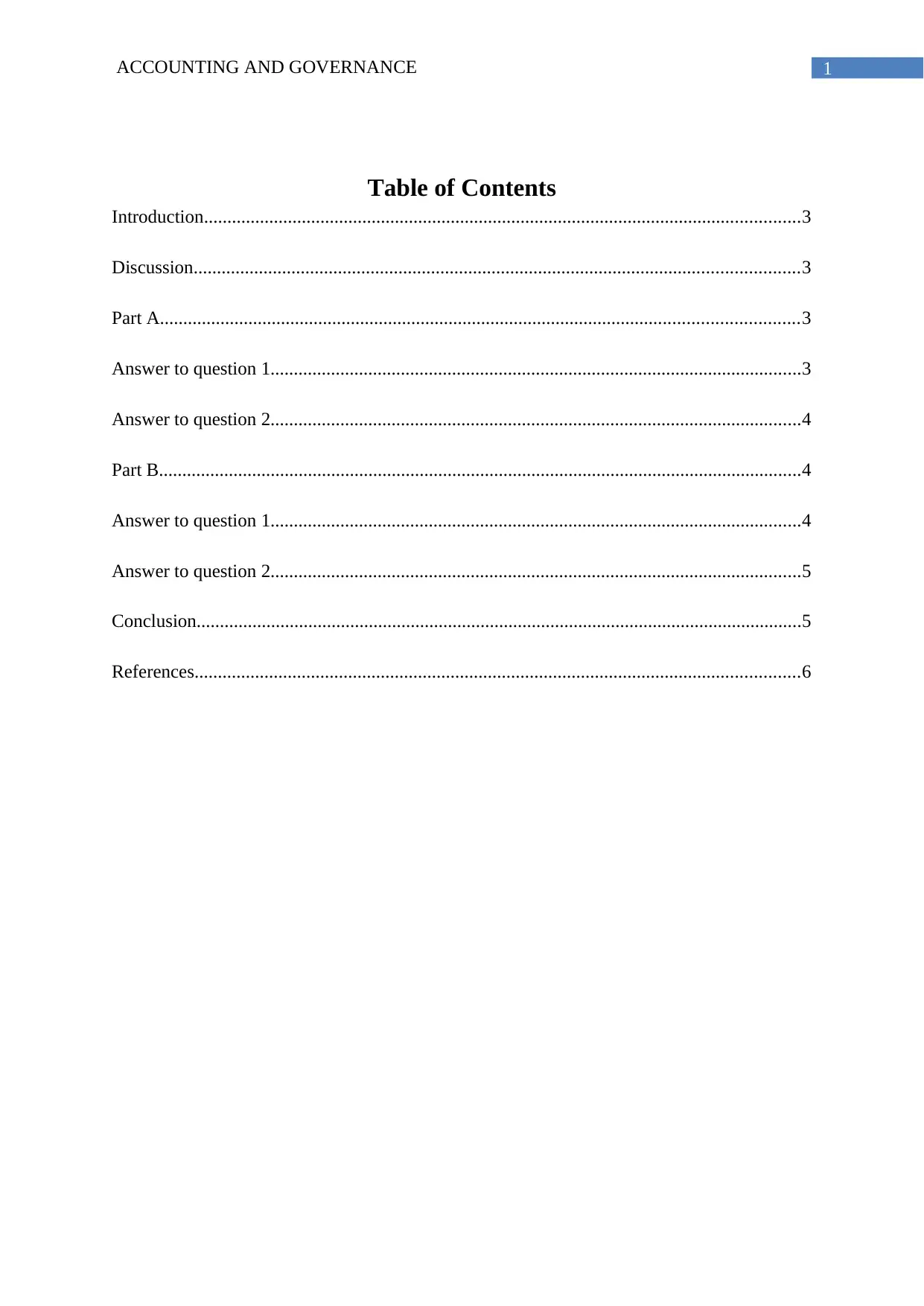
1ACCOUNTING AND GOVERNANCE
Table of Contents
Introduction................................................................................................................................3
Discussion..................................................................................................................................3
Part A.........................................................................................................................................3
Answer to question 1..................................................................................................................3
Answer to question 2..................................................................................................................4
Part B..........................................................................................................................................4
Answer to question 1..................................................................................................................4
Answer to question 2..................................................................................................................5
Conclusion..................................................................................................................................5
References..................................................................................................................................6
Table of Contents
Introduction................................................................................................................................3
Discussion..................................................................................................................................3
Part A.........................................................................................................................................3
Answer to question 1..................................................................................................................3
Answer to question 2..................................................................................................................4
Part B..........................................................................................................................................4
Answer to question 1..................................................................................................................4
Answer to question 2..................................................................................................................5
Conclusion..................................................................................................................................5
References..................................................................................................................................6
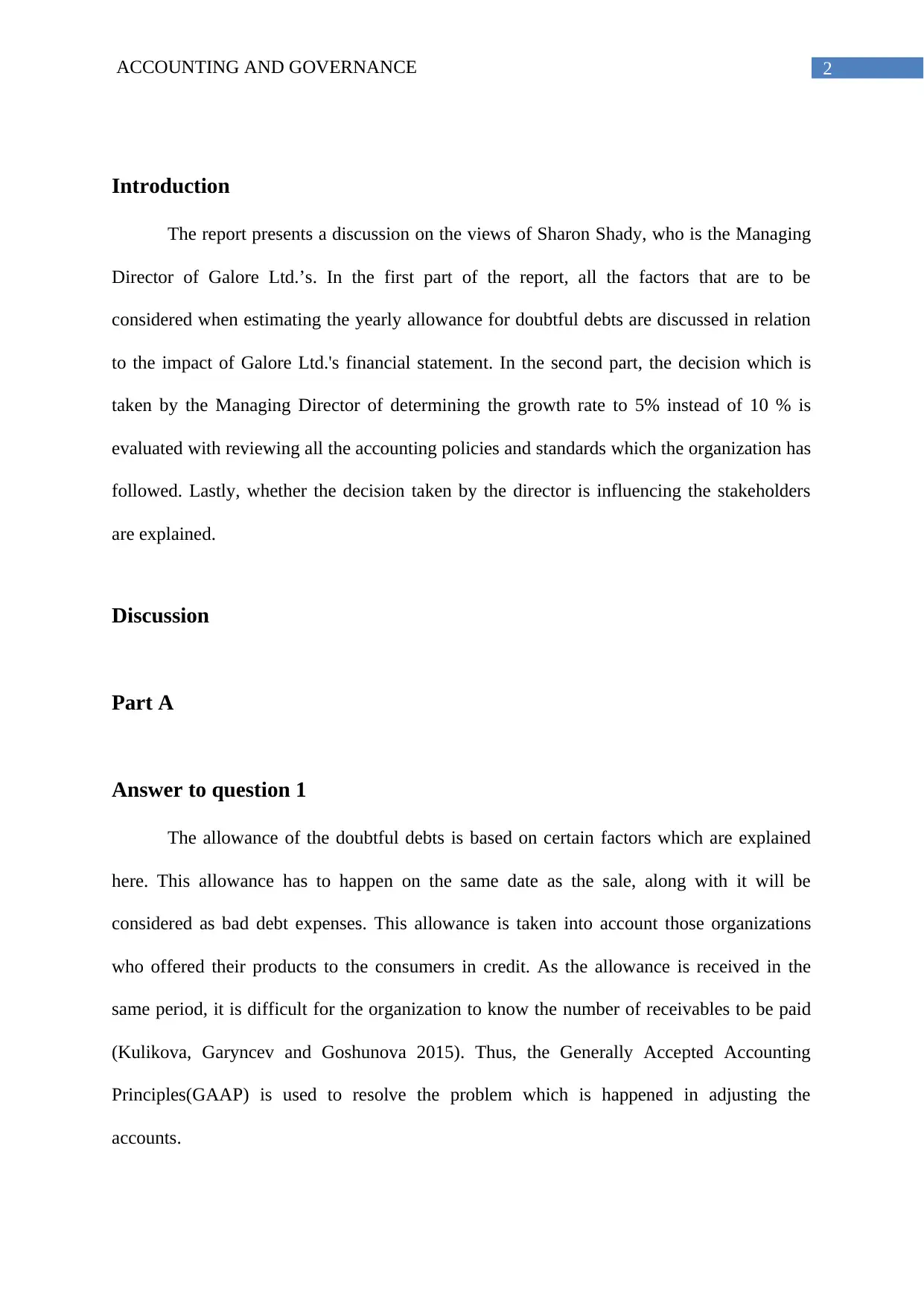
2ACCOUNTING AND GOVERNANCE
Introduction
The report presents a discussion on the views of Sharon Shady, who is the Managing
Director of Galore Ltd.’s. In the first part of the report, all the factors that are to be
considered when estimating the yearly allowance for doubtful debts are discussed in relation
to the impact of Galore Ltd.'s financial statement. In the second part, the decision which is
taken by the Managing Director of determining the growth rate to 5% instead of 10 % is
evaluated with reviewing all the accounting policies and standards which the organization has
followed. Lastly, whether the decision taken by the director is influencing the stakeholders
are explained.
Discussion
Part A
Answer to question 1
The allowance of the doubtful debts is based on certain factors which are explained
here. This allowance has to happen on the same date as the sale, along with it will be
considered as bad debt expenses. This allowance is taken into account those organizations
who offered their products to the consumers in credit. As the allowance is received in the
same period, it is difficult for the organization to know the number of receivables to be paid
(Kulikova, Garyncev and Goshunova 2015). Thus, the Generally Accepted Accounting
Principles(GAAP) is used to resolve the problem which is happened in adjusting the
accounts.
Introduction
The report presents a discussion on the views of Sharon Shady, who is the Managing
Director of Galore Ltd.’s. In the first part of the report, all the factors that are to be
considered when estimating the yearly allowance for doubtful debts are discussed in relation
to the impact of Galore Ltd.'s financial statement. In the second part, the decision which is
taken by the Managing Director of determining the growth rate to 5% instead of 10 % is
evaluated with reviewing all the accounting policies and standards which the organization has
followed. Lastly, whether the decision taken by the director is influencing the stakeholders
are explained.
Discussion
Part A
Answer to question 1
The allowance of the doubtful debts is based on certain factors which are explained
here. This allowance has to happen on the same date as the sale, along with it will be
considered as bad debt expenses. This allowance is taken into account those organizations
who offered their products to the consumers in credit. As the allowance is received in the
same period, it is difficult for the organization to know the number of receivables to be paid
(Kulikova, Garyncev and Goshunova 2015). Thus, the Generally Accepted Accounting
Principles(GAAP) is used to resolve the problem which is happened in adjusting the
accounts.
⊘ This is a preview!⊘
Do you want full access?
Subscribe today to unlock all pages.

Trusted by 1+ million students worldwide
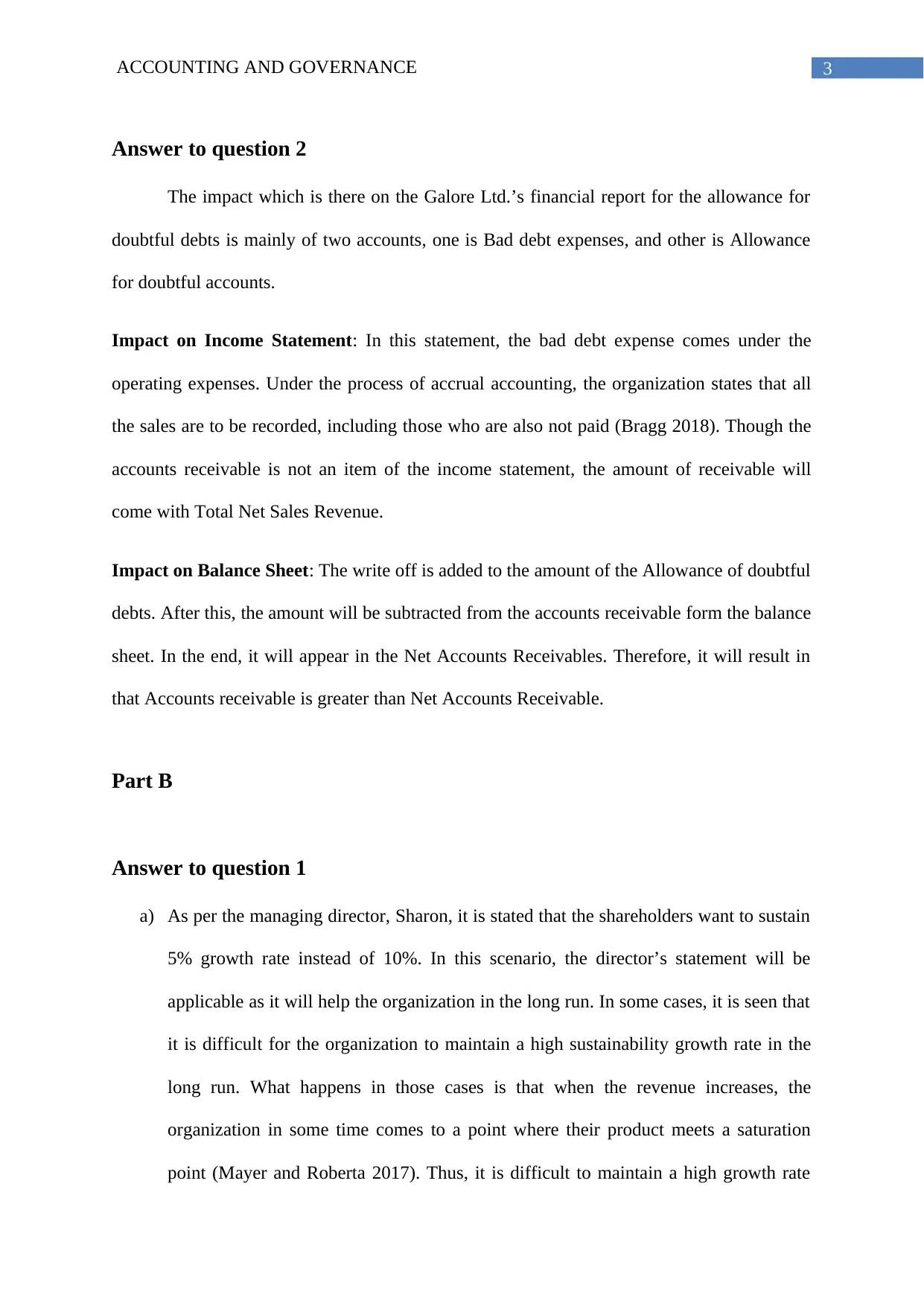
3ACCOUNTING AND GOVERNANCE
Answer to question 2
The impact which is there on the Galore Ltd.’s financial report for the allowance for
doubtful debts is mainly of two accounts, one is Bad debt expenses, and other is Allowance
for doubtful accounts.
Impact on Income Statement: In this statement, the bad debt expense comes under the
operating expenses. Under the process of accrual accounting, the organization states that all
the sales are to be recorded, including those who are also not paid (Bragg 2018). Though the
accounts receivable is not an item of the income statement, the amount of receivable will
come with Total Net Sales Revenue.
Impact on Balance Sheet: The write off is added to the amount of the Allowance of doubtful
debts. After this, the amount will be subtracted from the accounts receivable form the balance
sheet. In the end, it will appear in the Net Accounts Receivables. Therefore, it will result in
that Accounts receivable is greater than Net Accounts Receivable.
Part B
Answer to question 1
a) As per the managing director, Sharon, it is stated that the shareholders want to sustain
5% growth rate instead of 10%. In this scenario, the director’s statement will be
applicable as it will help the organization in the long run. In some cases, it is seen that
it is difficult for the organization to maintain a high sustainability growth rate in the
long run. What happens in those cases is that when the revenue increases, the
organization in some time comes to a point where their product meets a saturation
point (Mayer and Roberta 2017). Thus, it is difficult to maintain a high growth rate
Answer to question 2
The impact which is there on the Galore Ltd.’s financial report for the allowance for
doubtful debts is mainly of two accounts, one is Bad debt expenses, and other is Allowance
for doubtful accounts.
Impact on Income Statement: In this statement, the bad debt expense comes under the
operating expenses. Under the process of accrual accounting, the organization states that all
the sales are to be recorded, including those who are also not paid (Bragg 2018). Though the
accounts receivable is not an item of the income statement, the amount of receivable will
come with Total Net Sales Revenue.
Impact on Balance Sheet: The write off is added to the amount of the Allowance of doubtful
debts. After this, the amount will be subtracted from the accounts receivable form the balance
sheet. In the end, it will appear in the Net Accounts Receivables. Therefore, it will result in
that Accounts receivable is greater than Net Accounts Receivable.
Part B
Answer to question 1
a) As per the managing director, Sharon, it is stated that the shareholders want to sustain
5% growth rate instead of 10%. In this scenario, the director’s statement will be
applicable as it will help the organization in the long run. In some cases, it is seen that
it is difficult for the organization to maintain a high sustainability growth rate in the
long run. What happens in those cases is that when the revenue increases, the
organization in some time comes to a point where their product meets a saturation
point (Mayer and Roberta 2017). Thus, it is difficult to maintain a high growth rate
Paraphrase This Document
Need a fresh take? Get an instant paraphrase of this document with our AI Paraphraser
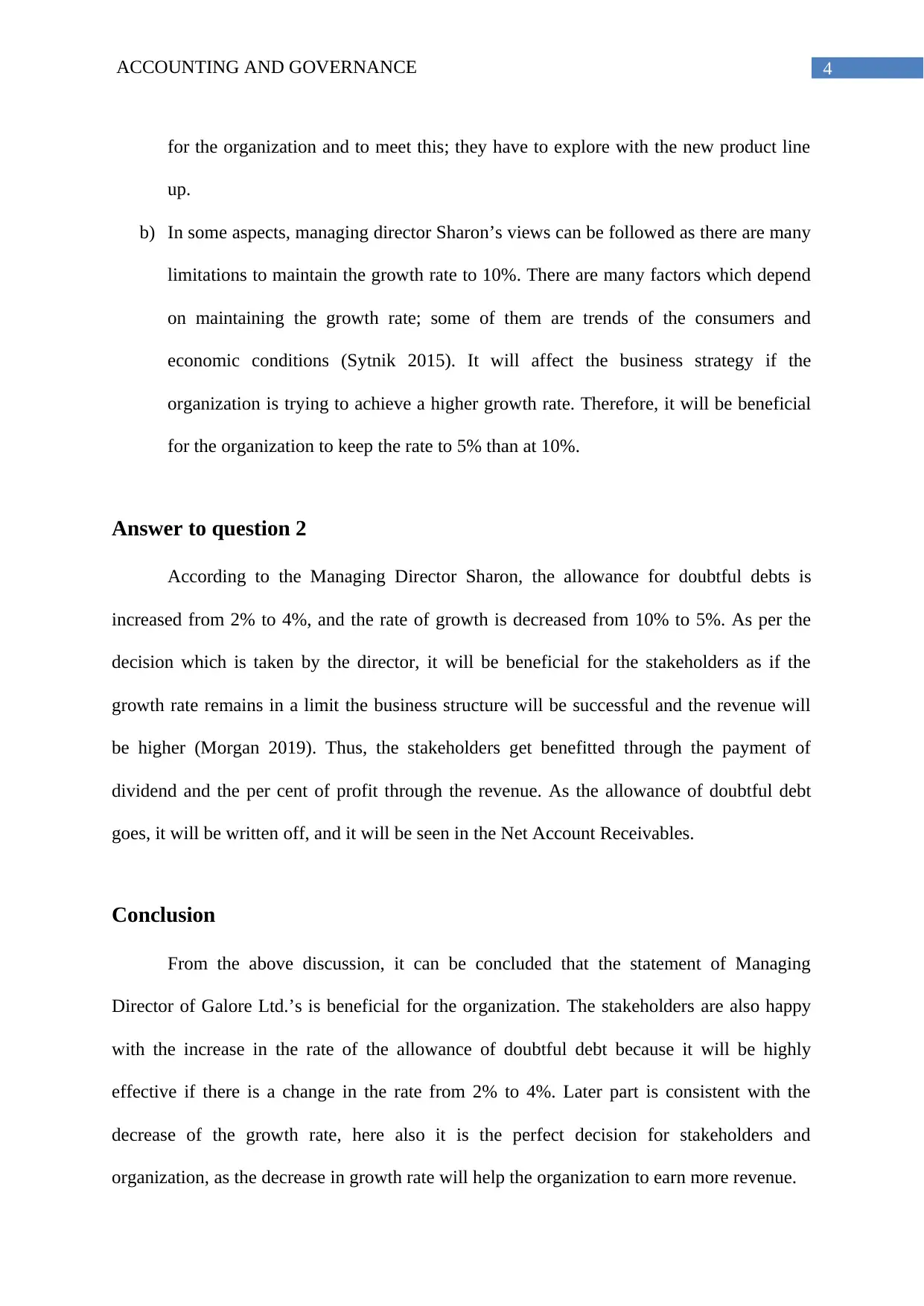
4ACCOUNTING AND GOVERNANCE
for the organization and to meet this; they have to explore with the new product line
up.
b) In some aspects, managing director Sharon’s views can be followed as there are many
limitations to maintain the growth rate to 10%. There are many factors which depend
on maintaining the growth rate; some of them are trends of the consumers and
economic conditions (Sytnik 2015). It will affect the business strategy if the
organization is trying to achieve a higher growth rate. Therefore, it will be beneficial
for the organization to keep the rate to 5% than at 10%.
Answer to question 2
According to the Managing Director Sharon, the allowance for doubtful debts is
increased from 2% to 4%, and the rate of growth is decreased from 10% to 5%. As per the
decision which is taken by the director, it will be beneficial for the stakeholders as if the
growth rate remains in a limit the business structure will be successful and the revenue will
be higher (Morgan 2019). Thus, the stakeholders get benefitted through the payment of
dividend and the per cent of profit through the revenue. As the allowance of doubtful debt
goes, it will be written off, and it will be seen in the Net Account Receivables.
Conclusion
From the above discussion, it can be concluded that the statement of Managing
Director of Galore Ltd.’s is beneficial for the organization. The stakeholders are also happy
with the increase in the rate of the allowance of doubtful debt because it will be highly
effective if there is a change in the rate from 2% to 4%. Later part is consistent with the
decrease of the growth rate, here also it is the perfect decision for stakeholders and
organization, as the decrease in growth rate will help the organization to earn more revenue.
for the organization and to meet this; they have to explore with the new product line
up.
b) In some aspects, managing director Sharon’s views can be followed as there are many
limitations to maintain the growth rate to 10%. There are many factors which depend
on maintaining the growth rate; some of them are trends of the consumers and
economic conditions (Sytnik 2015). It will affect the business strategy if the
organization is trying to achieve a higher growth rate. Therefore, it will be beneficial
for the organization to keep the rate to 5% than at 10%.
Answer to question 2
According to the Managing Director Sharon, the allowance for doubtful debts is
increased from 2% to 4%, and the rate of growth is decreased from 10% to 5%. As per the
decision which is taken by the director, it will be beneficial for the stakeholders as if the
growth rate remains in a limit the business structure will be successful and the revenue will
be higher (Morgan 2019). Thus, the stakeholders get benefitted through the payment of
dividend and the per cent of profit through the revenue. As the allowance of doubtful debt
goes, it will be written off, and it will be seen in the Net Account Receivables.
Conclusion
From the above discussion, it can be concluded that the statement of Managing
Director of Galore Ltd.’s is beneficial for the organization. The stakeholders are also happy
with the increase in the rate of the allowance of doubtful debt because it will be highly
effective if there is a change in the rate from 2% to 4%. Later part is consistent with the
decrease of the growth rate, here also it is the perfect decision for stakeholders and
organization, as the decrease in growth rate will help the organization to earn more revenue.
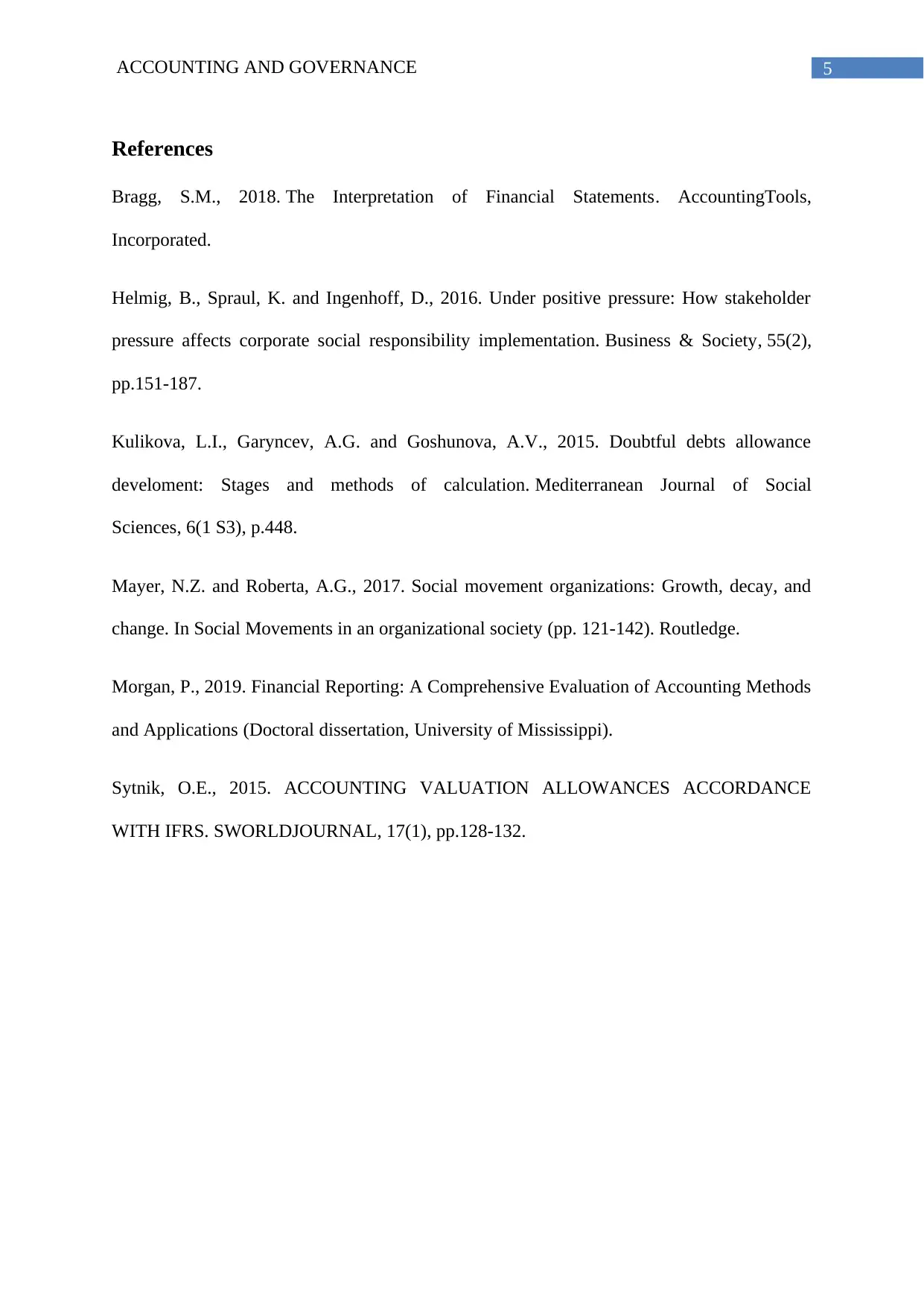
5ACCOUNTING AND GOVERNANCE
References
Bragg, S.M., 2018. The Interpretation of Financial Statements. AccountingTools,
Incorporated.
Helmig, B., Spraul, K. and Ingenhoff, D., 2016. Under positive pressure: How stakeholder
pressure affects corporate social responsibility implementation. Business & Society, 55(2),
pp.151-187.
Kulikova, L.I., Garyncev, A.G. and Goshunova, A.V., 2015. Doubtful debts allowance
develoment: Stages and methods of calculation. Mediterranean Journal of Social
Sciences, 6(1 S3), p.448.
Mayer, N.Z. and Roberta, A.G., 2017. Social movement organizations: Growth, decay, and
change. In Social Movements in an organizational society (pp. 121-142). Routledge.
Morgan, P., 2019. Financial Reporting: A Comprehensive Evaluation of Accounting Methods
and Applications (Doctoral dissertation, University of Mississippi).
Sytnik, O.E., 2015. ACCOUNTING VALUATION ALLOWANCES ACCORDANCE
WITH IFRS. SWORLDJOURNAL, 17(1), pp.128-132.
References
Bragg, S.M., 2018. The Interpretation of Financial Statements. AccountingTools,
Incorporated.
Helmig, B., Spraul, K. and Ingenhoff, D., 2016. Under positive pressure: How stakeholder
pressure affects corporate social responsibility implementation. Business & Society, 55(2),
pp.151-187.
Kulikova, L.I., Garyncev, A.G. and Goshunova, A.V., 2015. Doubtful debts allowance
develoment: Stages and methods of calculation. Mediterranean Journal of Social
Sciences, 6(1 S3), p.448.
Mayer, N.Z. and Roberta, A.G., 2017. Social movement organizations: Growth, decay, and
change. In Social Movements in an organizational society (pp. 121-142). Routledge.
Morgan, P., 2019. Financial Reporting: A Comprehensive Evaluation of Accounting Methods
and Applications (Doctoral dissertation, University of Mississippi).
Sytnik, O.E., 2015. ACCOUNTING VALUATION ALLOWANCES ACCORDANCE
WITH IFRS. SWORLDJOURNAL, 17(1), pp.128-132.
⊘ This is a preview!⊘
Do you want full access?
Subscribe today to unlock all pages.

Trusted by 1+ million students worldwide
1 out of 6
Related Documents
Your All-in-One AI-Powered Toolkit for Academic Success.
+13062052269
info@desklib.com
Available 24*7 on WhatsApp / Email
![[object Object]](/_next/static/media/star-bottom.7253800d.svg)
Unlock your academic potential
Copyright © 2020–2025 A2Z Services. All Rights Reserved. Developed and managed by ZUCOL.




